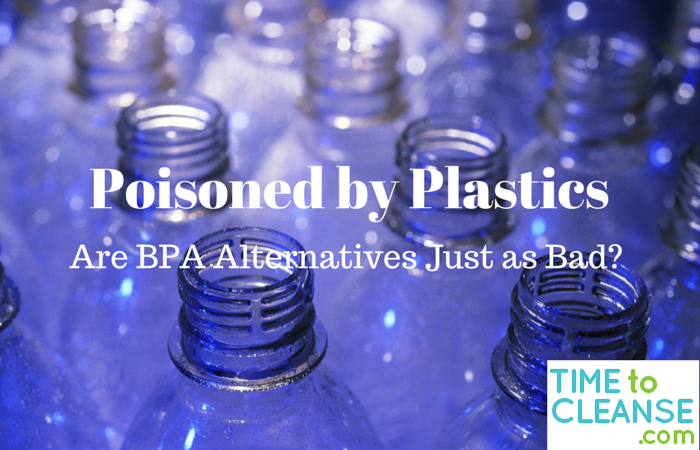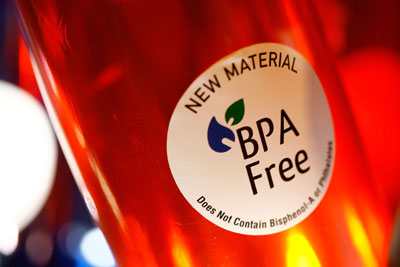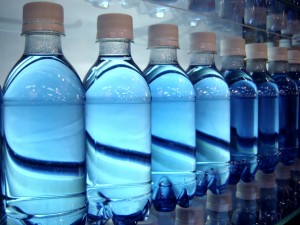As I write this, next to me sits a beautiful, shiny, clear cup with flowers on it. My mother, aware of my “toxic-free” preferences, got me this cup for Christmas.
It came packaged in a natural-looking brown box with a big blue sticker that said, “BPA-Free”. The clear green lid and bright green straw scream “Eco-Friendly”. However, every bit of this is just clever packaging and marketing, also known as “Green Washing”.
Quiz: Is Your Body TOXIC? Take the Test...
(get your free personalized report)
In the past, “BPA-Free” labeling has been just enough to ensure me that the chemicals from the plastic are not being leached into my water. However, the more I learn about plastics, BPA, and BPA-Free products, the more I am convinced I need to kick my plastic habit altogether!
What’s All The Fuss About Plastics and BPA?
Unless you have been living in a dark hole somewhere, you are likely aware that BPA is something you don’t want in your drink, food, or on your skin. However, if you have never fully understood what BPA is or why it’s so harmful, let me explain.
It is typically used to make plastics and epoxy resins. However, it was originally created as an estrogen replacement (female hormone). As with many things in the United States, no one really questioned the safety of this substance before releasing it into the mass market.
In the nineties and early part of the millennium, scientists began studying the effects of this chemical and the results were jaw-dropping. It is no surprise that the chemicals in BPA have mimicked estrogen in lab specimens.
The endocrine system is the network of glands that controls growth, metabolism, and brain function, with hormones as its chemical messengers. Naturally, this system plays a key role in fetal development. Scientists have tied BPA to ailments including asthma, cancer, infertility, low sperm count, genital malformations, early onset puberty, liver problems, and ADHD.
Despite the very best efforts of scientists not funded by chemical companies, BPA is still on the market. Many of us interface with BPA products daily, such as shower curtains, toothpaste tubes, cosmetic containers, baby toys, water bottles, insulated coffee mugs, food packaging, and even recycled paper, just to name a few.
Quiz: Is Your Body TOXIC? Take the Test...
(personalized report)
In 2008, there was a public outcry that led the FDA to ban BPA from baby bottles and sippy cups. However, their current stance is that, “BPA is safe at the current levels occurring in foods.”
Introducing “BPA-Free” Labeling & Greenwashing
Just like with my beautifully deceptive cup, “BPA-Free” is one of the better bait and switch schemes of our time. Instead of creating a product that would actually be less harmful, manufacturing companies just released a sister product to replace it.
In one study done in 2013, scientists concluded that rats exposed to BPS experienced rapid cell growth, cell death, and a release of the hormone prolactin. Prolactin is a hormone that is created in the pituitary gland and is primarily known as the “breast milk” hormone. When prolactin is released unnecessarily, it can lead to problems such as low sperm counts, milk production, genital malformations, an early onset of puberty, as well as adverse pregnancy symptoms.
Another study done in 2011 found that almost all commercially available plastic products tested, regardless of the type or origin, leached hormone-altering chemicals, including those advertised as BPA-Free.
It also states that in some cases, BPA-Free plastics released even more chemicals than the BPA products did! Pretty scary statistics if you ask me. This is what we are now feeding our babies with!
Some would like to argue that these tests are flawed because the rate of bisphenol exposure was much higher than our daily human exposure rate.
However, such is not the case. The most recent crackdown on BPS was at the University of Calgary in Canada. In this unique study, they exposed zebra fish to a rate of “less than a thousandfold of the acceptable human daily exposure”, and the animals still showed a 180%-240% increase in neuronal cell growth in their hypothalamus, even with astonishingly low trace amounts!
When exposed to BPS during a time frame equivalent to the second trimester, the fish tended to be much more hyperactive later on in life.
What Do We Do Now?
Instead of relying on biased chemical companies to “educate us” in regards to what is safe for consumption, it is time that we, as consumers, do our own research and put our money where our mouth is.
Since many of us don’t live in a glass bubble, here is some practical advice and information that is sure to help you lead a less plastic-centric existence.
1) Avoid Consuming Food & Beverages Stored in Plastic/Aluminum Containers
While the plastic goes without saying, most aluminum cans, from beer to green beans, are also lined with plastic. In addition, when products are shipped long distances, they may experience a wide range of temperature fluctuations, leaching chemicals into your food, beverage, or household products.
2) Do Not Heat Plastic
Heat causes chemicals to be released from plastic, whether something direct like a microwave or something indirect like sunlight. Be mindful of this when you leave a water bottle sitting in your car all day, throw toys into your child’s bathwater, microwave food, or use the dishwasher (especially to “disinfect” baby toys).
3) Use Glass, Stainless Steel, Wood, and Ceramic Whenever Possible
Manufacturers are listening to consumers. While the movement is not as quick as some of us may prefer, there are affordable and practical options available. Remember, if it smells like plastic, it is leaching chemicals!
Try making these simple swaps…
- For beverages on the go (i.e. water bottles, sippy cups, and baby bottles), switch to stainless steel or glass. Most glass water bottles come with a protective silicone sleeve for minimal breakage. There are even stainless steel straws. For babies, opt for silicone nipples if necessary.
- When consuming adult beverages, stick to glass bottles and only buy wines with natural corks.
- For food packaging and storing, swap the plastic for glass/stainless steel, try a Reusable Sandwich Bag and instead of plastic wrap, try Bees Wax Wraps – You can purchase them or try making them for yourself.
- While shopping, skip the produce bag and try to buy breads in paper bags. Always remember to carry cloth bags in the car, so you’re prepared.
- For grooming products, try making your own cosmetics/household cleansers, and be sure to store in glass containers.
- In the bathroom, swap the plastic shower curtain for hemp, which will naturally repel bacteria and mildew. And ditch the plastic toothbrush for a bamboo one!
- In the office, you can find calculators, keyboards, mice, and laptops all made with bamboo!
- For women, switch to feminine products that don’t use/contain plastic, like Natracare, or try washable tampons and pads.
- For babies, try cloth diapers, or a newer hybrid diaper called gdiapers – they provide a cloth diaper with a disposable biodegradable insert. Choose wooden toys & organic cotton teethers.
- For your pets, nix the poisonous plastic flea colors and try essential oils and a bandana. Also, serve your pets’ food/water in stainless steel/glass bowls.
4) Rethink What You Thought About Recycling!
While you may get a sense of responsibility by recycling, don’t let that go to your head! With the cost/resources it takes to recycle plastics, some are finding that it is not cost-effective or environmentally friendly. In fact, did you know that for a long time, we have been exporting our trash/recycling to China? 25% of the items we ship over are going directly to landfills anyway, putting more chemicals into our Earth! China has recognized this waste, and responded with Operation Green Fence. Pretty soon, we are going to have to figure out what to do with all of this plastic!
5) Be on Alert, Plastic Lurks in Strange Places!
- Many companies such as Aveeno, Neutrogena, and Crest Toothpaste enhance their products using “microbeads”. These tiny, plastic filaments are added to “exfoliate” or “polish” but they should be avoided. Not only are we exposing ourselves to these chemicals, we are also exposing the environment. A study done on the Great Lakes, one of America’s largest natural water sources, found 1.1 million plastic particles (microbeads) per square kilometer.
- Polyvinyl Acetate is used to make chewing gum.
- Paper products, such as thermal receipt tape and money, are often manufactured with BPS.
- Keep your eyes out for an ingredient, ADA (azodicarbonamide) in your food products. This ingredient is often added to breads to give it a more spongy effect, just like your yoga mat/flip flops! For more information, check out this interesting article by the Environmental Working Group.
References/Citations:
http://ehp.niehs.nih.gov/1205826/
http://www.ncbi.nlm.nih.gov/pmc/articles/PMC2774166/
http://www.ncbi.nlm.nih.gov/pmc/articles/PMC3554682/
http://www.pnas.org/content/112/5/1475.abstract
http://www.motherjones.com/environment/2014/03/tritan-certichem-eastman-bpa-free-plastic-safe



